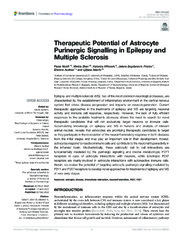Приказ основних података о документу
Therapeutic Potential of Astrocyte Purinergic Signalling in Epilepsy and Multiple Sclerosis
| dc.creator | Nobili, Paola | |
| dc.creator | SHEN, Weida | |
| dc.creator | Milicevic, Katarina | |
| dc.creator | Bogdanović Pristov, Jelena | |
| dc.creator | Audinat, Etienne | |
| dc.creator | Nikolic, Ljiljana | |
| dc.date.accessioned | 2023-03-15T19:55:42Z | |
| dc.date.available | 2023-03-15T19:55:42Z | |
| dc.date.issued | 2022 | |
| dc.identifier.issn | 1663-9812 | |
| dc.identifier.uri | http://rimsi.imsi.bg.ac.rs/handle/123456789/1813 | |
| dc.description.abstract | Epilepsy and multiple sclerosis (MS), two of the most common neurological diseases, are characterized by the establishment of inflammatory environment in the central nervous system that drives disease progression and impacts on neurodegeneration. Current therapeutic approaches in the treatments of epilepsy and MS are targeting neuronal activity and immune cell response, respectively. However, the lack of fully efficient responses to the available treatments obviously shows the need to search for novel therapeutic candidates that will not exclusively target neurons or immune cells. Accumulating knowledge on epilepsy and MS in humans and analysis of relevant animal models, reveals that astrocytes are promising therapeutic candidates to target as they participate in the modulation of the neuroinflammatory response in both diseases from the initial stages and may play an important role in their development. Indeed, astrocytes respond to reactive immune cells and contribute to the neuronal hyperactivity in the inflamed brain. Mechanistically, these astrocytic cell to cell interactions are fundamentally mediated by the purinergic signalling and involve metabotropic P2Y1 receptors in case of astrocyte interactions with neurons, while ionotropic P2X7 receptors are mainly involved in astrocyte interactions with autoreactive immune cells. Herein, we review the potential of targeting astrocytic purinergic signalling mediated by P2Y1 and P2X7 receptors to develop novel approaches for treatments of epilepsy and MS at very early stages. | sr |
| dc.language.iso | en | sr |
| dc.publisher | Frontiers Media | sr |
| dc.relation | info:eu-repo/grantAgreement/MESTD/inst-2020/200007/RS// | sr |
| dc.relation | info:eu-repo/grantAgreement/MESTD/inst-2020/200178/RS// | sr |
| dc.relation | info:eu-repo/grantAgreement/MESTD/inst-2020/200053/RS// | sr |
| dc.relation | Grants from European Commission (H2020 MSCA-ITN EU-GliaPhD No. 72205) | sr |
| dc.relation | Agence Nationale de la Recherche (contract numbers: ANR-19-CE16-0018-03 and ANR-20CE16-0003-02) | sr |
| dc.relation | Grants from Science and Technology Department of Zhejiang Province (2018C37131) | sr |
| dc.relation | Scientific Research Foundation for Returned Scholars of Hangzhou City (2019) | sr |
| dc.rights | openAccess | sr |
| dc.rights.uri | https://creativecommons.org/licenses/by-sa/4.0/ | |
| dc.source | Frontiers in Pharmacology | sr |
| dc.subject | astroglia | sr |
| dc.subject | disease | sr |
| dc.subject | intercellular interaction | sr |
| dc.subject | neuroinflammation | sr |
| dc.subject | P2X7 | sr |
| dc.subject | P2Y1 | sr |
| dc.title | Therapeutic Potential of Astrocyte Purinergic Signalling in Epilepsy and Multiple Sclerosis | sr |
| dc.type | article | sr |
| dc.rights.license | BY-SA | sr |
| dc.citation.spage | 900337 | |
| dc.citation.volume | 13 | |
| dc.identifier.doi | 10.3389/fphar.2022.900337 | |
| dc.identifier.fulltext | http://rimsi.imsi.bg.ac.rs/bitstream/id/4655/fphar-13-900337.pdf | |
| dc.type.version | publishedVersion | sr |

